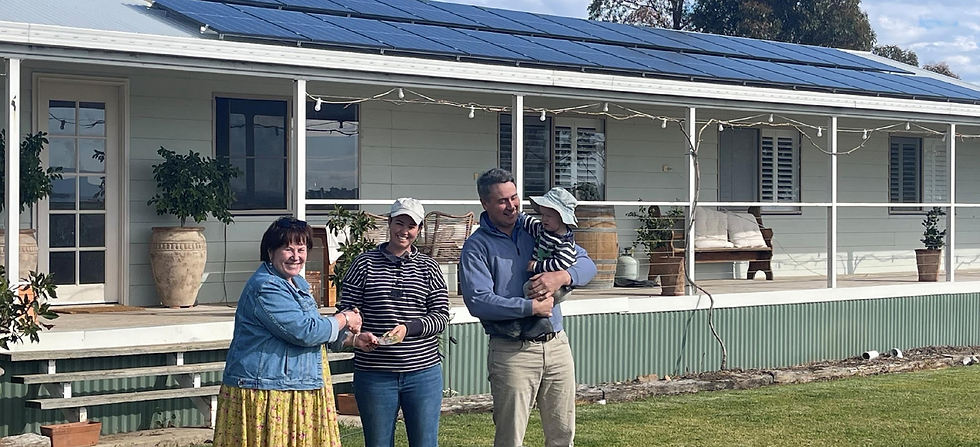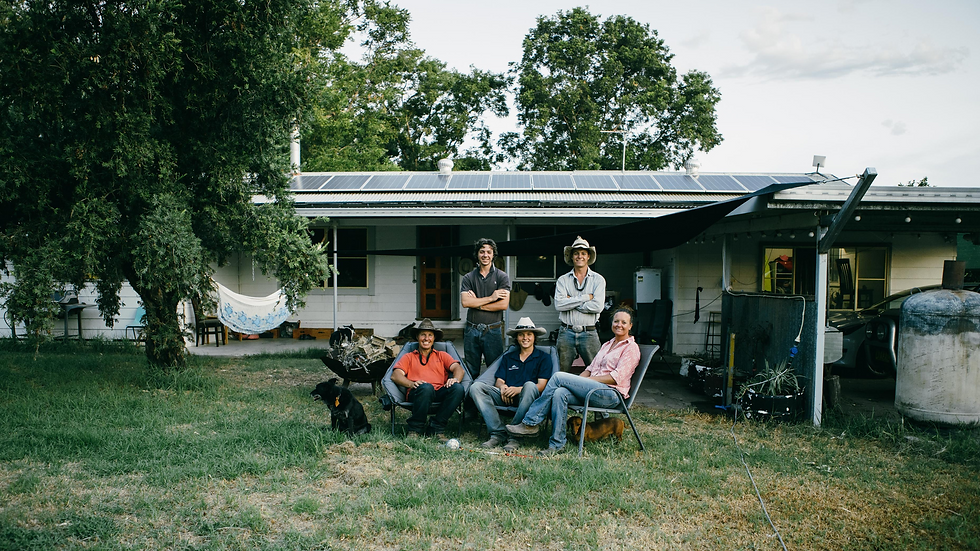Power to the People: Electrifying Our Future Together
- Sally Hunter

- Aug 18
- 4 min read
For decades, electricity has been something in the background. Flip the switch. Pay the bill. Move on. But with costs rising and climate impacts accelerating, many of us are starting to ask: what if we could take more control of our energy? What if we could keep more of the benefits here in our own communities?
At Geni.Energy, that question has been at the heart of our work since 2020. And the answer is becoming clearer every day: communities can lead the energy transition.

The Red Neck Tesla: Our EV Story
When we bought our first electric vehicle three and a half years ago, people thought we were mad. We live 50 kilometres from town on gravel roads, we run a farm, and we drive every day. But our “red neck Tesla” has clocked more than 115,000 kilometres, through floods, droughts, and plenty of dirt tracks.
The numbers speak for themselves. A daily 100km round trip in a diesel ute would cost about $20 in fuel. In our EV, on a good sunny day, it is completely free. Worst case, it costs about $7. That is thousands of dollars saved every year. Add to that no servicing, and the benefits are enormous.
Charging is not the problem people think it is. Every power point in Australia is a charging station - more than half a billion of them. Many farms already have 15-amp power points, and we installed a 32-amp outlet at home for faster charging.
We regularly road trip to Sydney, stopping at Hollydeen Winery, and usually the car finishes charging before we finish lunch.

Solar’s Shifting Economics
Solar has been a game changer for households and community groups across our region. We have helped local halls and non-profits halve their electricity bills with rooftop systems.
But the market is changing. Exporting power to the grid no longer pays what it used to. At our place, we once needed to export 15 kWh a day to cover our fixed daily fee. Now we would need to export 70 kWh to achieve the same result. The excess energy you sell back to the grid through an electricity retailer is now worth just a few cents - cents that lose value each year.
Enter Batteries and the Virtual Power Plant
The good news is that technology is catching up. Instead of sending your solar away for almost nothing, you can keep it. Batteries allow you to store that excess energy to run your hot water, pump water, charge your car, and power your home after the sun goes down.
Our own system - 8kW of solar with 10kWh of battery storage - powers our family of five and our EV for about $200 a month (mostly in fixed fees). And when households and community batteries are linked together into a Virtual Power Plant (VPP), the benefits multiply. Shared energy, shared profits, and stronger local control. Also more and more people are now trading on the wholesale electricity market through companies such as Amber.

Here in Narrabri, our upcoming community battery will support the local grid, absorbing excess day time solar and providing it back during peak demand, while also featuring local artwork, supporting community projects, and sparking important conversations.
Using the Grid We Already Have
The electricity grid we grew up with was a one-way street, sending power from coal stations to the bush. The new grid is flexible, smart, and participatory. Every home, every shed, every town can be both a user and a contributor.
Essential Energy has identified 8 gigawatts of unused capacity in its grid network. This is capacity that can support more renewable energy without building new transmission lines. By capturing and storing excess solar locally, we can prevent curtailment, make better use of our free energy, and reduce the need for costly infrastructure.
Power With Purpose
When you invest in community-owned projects like Manilla Solar, or join a community battery or electrification group, you are not just saving money. You are shifting power - literally and figuratively - back to the community. You are making sure the benefits of the energy transition stay local.
And you are joining a growing movement of people who are tired of being passive consumers and are ready to become active participants.
Why Communities Must Lead
The transition is happening, but rural communities risk being left behind if they are not active players. Or worse, they risk being told to simply accept large-scale changes without input or benefit.
Yet regional areas are also where the greatest opportunities lie. We already have too much solar in the day, and new ideas are emerging to use that free energy. From running irrigation pumps, to electrifying transport, to unlikely stories like a pig farmer in Biloela who turned excess energy from biogas into bitcoin mining - rural Australia is fertile ground for innovation.
A Shared Future
Electricity is becoming like water in Australia once was - something we took for granted until we realised its limits. Just as we learned to capture rainwater, build tanks, and use greywater wisely, now we must learn to manage energy in smarter ways.
At Geni.Energy, we believe every home can be a power station, every town a microgrid, and every community a player in the new energy system.
The future is not just electric. It is connected, it is beautiful, and it is ours if we choose it.

Call to Action
Want to be part of the change? Follow the progress of the Narrabri Community Battery, get involved in a Local Energy Hub, or subscribe to our emails or join us at Geni.Energy events. Together, we can make sure the energy transition works for all of us.



Comments